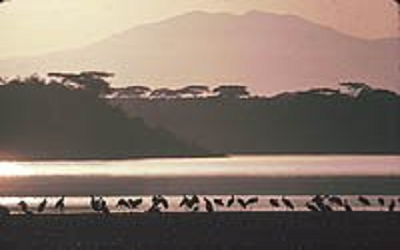| |
Getting There
What airlines fly to Tanzania?
The nearest international airport to the Serengeti is Kilimanjaro Airport near Arusha. KLM is currently the only international airline that flies directly into Arusha (on Tuesday, Friday and Saturday from Amsterdam). Other airlines such as Swissair will fly into Nairobi, Kenia (from Zurich) or Dar-es-Salaam, from where you can get a connecting flight to Arusha.
How do I get to the Serengeti?
By car: The main access road into the Serengeti from Arusha passes the gate of Lake Manyara National Park, mounts the Rift Valley Escarpment, goes on through communal farming lands to the Ngorongoro Crater Conservation Area, drops down onto the plains past Olduvai Gorge to the east, and enters the Serengeti through Naabi Hill Gate. The distance is 325 km and the drive takes around eight hours. At Seronera and Lobo, garage facilities are available to refuel cars. Breakdown facilities, however, are virtually non-existent.
By plane: Internal flights by light plane from Arusha to the Seronera Airstrip in the heart of Serengeti or to Kirawira Airstrip in the Western Corridor cost 135 US$ per person one way. The cost of charter flights varies widely.
Accomodation
Safari Lodges
The term and the concept of the Safari Lodge are of Tanzanian origin. Here you will find buildings of exciting design, specially build to fit in with the wild landscape of the parks, yet with all the amenities of a luxury hotel, such as swimming pools and fine food. As you eat, drink, laze by the pool or sit on your private veranda, you will be able to observe game, often at only a few yards distance.
Luxury Tented Camps
The are a few Luxury Tented Camps in the Serengeti offering an absolutely unique Safari experience. The tents usually offer fully equipped en-suite bathrooms, private verandas and elegant furniture. At night you can listen to the wild sounds of the Serengeti cuddled up in a warm and comfortable bed!
Organised Safaris
If you go on an organised Safari with a tour operator you will mostly sleep in mobile camps. Here facilities are more limited. The tents usually have simple beds with lining and duvets, camping toilets and showers depending on the Safari Operator.
Camping
A much cheaper alternative is to stay on one of the Serengeti's nine campsites. If you wish to stay at them you must obtain permission from TANAPA or the nearest park warden.
Wildlife
How is the wildlife?
Wildlife viewing in the Serengeti ecosystem with its Great Migration is tremendous! Nowhere on earth is there a sight rivalling the spectacle of 1.5 million hoofed animals on the march. Serengeti has the highest concentration of large mammals on this planet and is famous for its 2,500 lions, the highest concentration found anywhere! Unlike in Kenya (and with the exception of the Ngorongoro Crater), you rarely see other tourists or vehicles on a game drive in the Serengeti National Park.
How is the birding?
Early and late daylight hours are usually the best times to observe the more than 518 species of birds (bird-checklist pdf) which have been identified in the Serengeti. Some of them are Eurasian migrants who are present in the European winter months from October to April.
Are wild animals dangerous?
Wild animals can be dangerous and you should not wander off on your own, especially at night, while on safari. However most animals are rather frightened by humans and will flee instead of attacking unless cornered or provoked. Keep a sensible distance and treat them with respect.
Food and Water
Most visitors are surprised by the quality and the variety of the food available on safari. No matter whether you are staying in a lodge, a tented camp or a mobile safari camp, you will be served freshly prepared food according to international tastes and standards.
Bottled water can be purchased at all the lodges and camps and is provided by all Safari Operators. Non alcoholic drinks are often included in the all inclusive rates. It is wise to stick with bottled drinks.
Health
When travelling to Tanzania a course of anti malaria tablets is essential and many doctors also advise a Hepatitis A vaccination. All childhood vaccinations, especially Tetanus, should be up to date. Malaria prophylaxis and a stand-by suppressant (as well as insect repellents) are advised. When entering Tanzania a proof of immunisation against Yellow Fever is required. We highly recommend that you consult a local travel health specialist at least 6 weeks before travelling.
Medical facilities in Tanzania are limited, and medicines are often unavailable. Doctors and hospitals often expect immediate cash payment for health services. In case of serious medical problems we recommend immediate evacuation to your home country or hospitalization in Nairobi, Kenya.
Weather
The Serengeti falls into the classic bimodal rain pattern of East Africa. The short rains are concentrated in November/December, the long and heavier rains in March - May.
Mean monthly maximum temperatures are relatively uniform throughout the year being constant around 27 to 28 degrees centigrade (or 75 - 80 degrees Fahrenheit) at Seronera. At Ngorongoro Crater the nights can be very chilly due to altitude.
What is the best time to visit Serengeti?
Any time other than during the long rains in April and May is a perfect time to be on Safari in Northern Tanzania. Game viewing and the number of other tourists varies widely according to the seasonal concentrations of wildlife . Most Safari operators will adjust their itineraries accordingly.
Packing
Small aircraft which are often used for transfers within Tanzania limit your baggage to 10 - 15 kg (25 - 30 pounds) per person. It is advisable to carry your luggage in soft bags rather than hard sided suitcases.
What clothes should I bring?
On Safari comfortable cotton clothing in subdued safari colours is very practical. During the day, shorts or casual lightweight trousers are ideal, but the nights can get chilly, so do not forget to bring a few warm sweaters. After sunset long sleeves limit the chance of being bitten by mosquitoes. You should also bring a pair of comfortable, closed walking shoes as well as a pair of sandals.
Furthermore, your packing checklist should include:
- a hat, sunglasses and sunscreen
- insect repellent
- a small flashlight
- malaria stand-by medication + first aid kit
- passport (6 month valid) + vaccination certificate
- a sufficient amount of cash and/or traveller cheques
- plenty of films
- and a good deal of patience and a sense of humour - for this is AFRICA!
Money
The official currency of Tanzania is Tanzanian shillings and cents. However, US dollars are mostly favoured.
You will need very little spending money on most safaris as the majority of meals and activities are included in your package cost. Bills may be settled by US cash, by travellers cheques or by credit cards. Please do not rely on automatic teller machines (ATM's) to withdraw currency with your credit card. Make sure you bring enough cash with you in US dollars or carry a sufficient number of travellers cheques (see below).
US cash or travellers cheques can be changed into local currency at airports and banks. Small bills are best. Do not exchange too much money, as US dollars are mostly favoured and you will lose a considerable amount of money changing it back.
The current official exchange rate is: 1 US$ = 790 TSH
This exchange rate should only affect you if you use international credit cards (which makes using them very expensive - so better keep the plastic for emergencies!) Sticking with cold hard cash or traveller cheques, there are Forex bureaus in most cities offering much more favourable free-market exchange rates.
Tipping
Tipping at restaurants (at your discretion) is 10%. We recommend tipping US$5 for each traveller per day at lodge based safaris; US$ 10 per day for your driver guide and US$5 each per day for the camp staff when camping on mobile safaris.
Taking Photographs
Make sure you take sufficient film for your trip! We recommend a lens of at least 200mm for wildlife photography.
Souvenirs
Shopping in the Serengeti naturally is extremely limited due to the absence of human settlements. In Arusha, however, and other major towns you will find curio markets where you can buy all sorts of carvings, masks, Maasai spears, textiles, drums, jewelry etc. The Arusha Heritage Centre offers a large variety of souvenirs and crafts.
Language
Swahili, otherwise known as Kiswahili, is the main language of Tanzania. English is spoken widely throughout the country.
Electricity
The main electricity supply is 240 volts. Many lodges and tented camps operate their own generators or solar lighting systems providing intermittent electricity.
Park's Fees and Regulations
Park's fees can be very expensive in Tanzania. If you book your trip through a travel agent they are generally included in the overall trip cost.
In Serengeti National Park and Ngorongoro Conservation area the park fee is US$ 25 per person per day and US$ 30 per vehicle per day.
There is a number of definite "don'ts" in the Serengeti. These include approaching too close and disturbing animals, making an unacceptable noise, picking flowers or destroying vegetation, discarding litter, exceeding 50km/h speed limit, bringing pets or firearms into the Park, and going off the roads within 16km of Seronera.
Visa and Entry Requirements
All visitors require a visa except citizens of some Commonwealth countries and a few other nations. The cost of the entry visa varies according to your nationality. Visas can be obtained upon arrival in Arusha or Dar-es-Salaam at a cost of US$ 50 or issued by your nearest Tanzanian High Commission before departure.
Security
As in most major cities throughout the world street crime including mugging, petty and vehicle theft is common in Tanzania. A good practice is to leave valuables, such as cash, passports, and airline tickets, locked away or under the supervision of your camp/ lodge manager.
Please keep in mind that road conditions are usually bad and the safety of Public Transportation is poor.
To Top of Page
|















